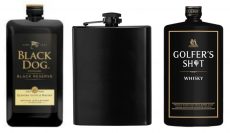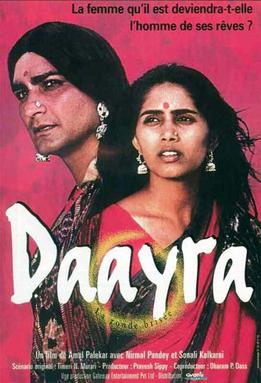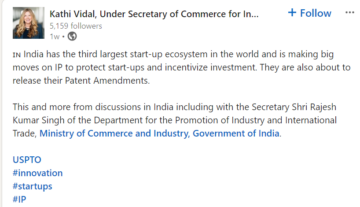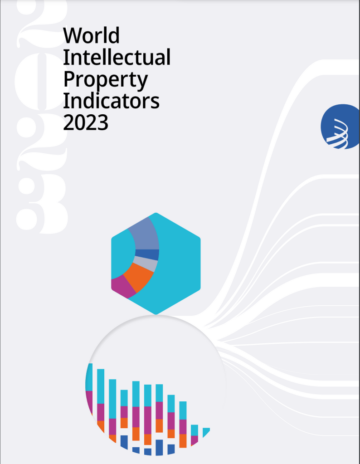We’re pleased to bring to our readers a guest post by Akshat Agrawal on the recent order by the Delhi High Court on the ‘Hipster bottle design’ controversy. Akshat is an LLM student at Berkeley Law specialising in IP policy. He is a graduate of Jindal Global Law School and has previously clerked at the Delhi High Court. He’s written several posts for us in the past and they can be found here.
Monopolizing the Hipster? – Test of Design Infringement by the Delhi High Court
Akshat Agrawal
 Recently in Diageo Brands v. Alcobrew Distilleries, a single bench of Justice C. Hari Shankar of the Delhi High Court, dismissed the Plaintiff’s application for temporary injunction against the alleged action of design infringement under Section 22(1) of the Designs Act, 2000. The main holding of the Court, captured in paragraph 159 of the order, is that prima facie, “the aspect of design piracy under S. 22(1) of the Designs Act has to be examined from the point of view of the instructed eye of a person who is instructed with prior art, reasonably discriminatory and able to appreciate detail.” The Court has rejected the applicability of the test of the eyes of the average customer who sees bottles on a shelf from a distance, as roughly applied in trademark infringement cases. The Court also held that novelty and originality of the suit design vis-à-vis the prior art is relevant while examining infringement.
Recently in Diageo Brands v. Alcobrew Distilleries, a single bench of Justice C. Hari Shankar of the Delhi High Court, dismissed the Plaintiff’s application for temporary injunction against the alleged action of design infringement under Section 22(1) of the Designs Act, 2000. The main holding of the Court, captured in paragraph 159 of the order, is that prima facie, “the aspect of design piracy under S. 22(1) of the Designs Act has to be examined from the point of view of the instructed eye of a person who is instructed with prior art, reasonably discriminatory and able to appreciate detail.” The Court has rejected the applicability of the test of the eyes of the average customer who sees bottles on a shelf from a distance, as roughly applied in trademark infringement cases. The Court also held that novelty and originality of the suit design vis-à-vis the prior art is relevant while examining infringement.
Context
The Plaintiff claimed protection of its hipster design of a whiskey bottle, supposedly modelled on the shape of a smartphone which could conveniently be carried in the hip pocket. It claimed novelty over its rectangular shape, its smooth rounded shoulders, V-shaped neck, rimmed rounded cap and dimpled bottom, claiming it to be distinctive and strikingly perceptive. The Defendant disputed this supposed claim to a monopoly over the hipster tag and features, arguing it to refer to a person, who during times of prohibition, used to carry a hip flask- a prior art. Defendant further asserted that design features claimed are common to liquor trade and the dimpled base is a functional feature for stability and could not be legally excludable.
The Court rejected the incongruent argument of the Plaintiff that- although registration and novelty in respect thereof is to be adjudicated based on the instructed eye, infringement should be adjudicated from the perspective of an average consumer who has no idea of the prior art, solely on visual effect. The cogent rationale used by the Court, consistent with international standards of design infringement while dismissing this argument, is encapsulated in paragraph 164. Court stated- given the threshold of design protection requires novelty vis-à-vis prior art, an average consumer, viewing the products from a distance of six to eight yards, cannot be given the authority to determine whether something is infringing or not, lest there would be potential to monopolize prior art or non-novel aspects of a design. While taking this view, the Court digressed from the non-binding precedent of another Single judge of the Delhi HC in Diageo v. Great Galleon.
Analysis
The logic of differentiating principles of design infringement with principles of trademark infringement is sound. Trademark law is not a tool of incentivizing creation or production. It is a tool of source identification for the benefit of consumers that associate a certain amount of goodwill with a distinctive brand identity. The policy objective is to ensure average consumers in a marketplace are not confused or deceived, and their search costs are reduced through distinctiveness. As a corollary, this protects investment of distinctive brands in their goodwill development. Trademark thus requires either registration that underscores need for a distinctive identity for the average consumer, or pre-established goodwill and reputation through use. The first user of a distinctive mark who either seeks registration or establishes goodwill gets protection, as in the eyes of the average consumer- it is this identity that distinguishes it from other producers of similar products. It is thus that the focus of the enquiry of whether a mark is infringing or not is from the perspective of the average consumer, likely to get confused by deceptive similarity. Given the target of policy is protecting this consumer, it is most prominent for their lens to be adopted while adjudicating confusion and infringement.
Design law on the other hand is a tool to incentivize/ enable the production of novel and original designs by giving legal inducement in the form of limited market excludability. It is not a tool of source identification or to avoid consumer confusion and is rather only a legal inducement due to the law’s skepticism associated with the producer shifting to marginal sources of income if the design is allowed to be imitated. The market power, thus, is limited to what the law seeks to induce i.e., production of novel and original designs. It is only when such novelty is proven that the design is registered, and it is only when the said design is registered that the market power to exclude others begins. Here, an average consumer has no idea about this specific novelty vis-à-vis prior art, and thus expecting two designs to be infringing merely due to their “look and feel” or due to them seeming to be imitated to the naked eye is ignorant of the law’s specific and limited inducement of novelty. Two designs can be substantially similar for the perceptive eye yet incorporating only prior art similarity. Allowing a motion of infringement is such a situation, defending the same on the rationale of deception or free riding in the eyes of the average perceiver of the design, would monopolize such prior art in the hands of the registrant.
The ordinary observer, if one, for the purposes of design infringement must be familiar with prior art. Internationally, this standard is fixated in design infringement analysis- in the Egyptian Goddess case of the US, the Baili v. Apple, Beijing IP Office Decision case in China (summarized in English here), and a mode radical informed user test in EU (Julius Samann, Ltd. v. Kubi spol., case no. R1999/2013-3 (OHIM Bd. Appeal, Jan. 20, 2016) and Pepsico v. Grupo Promer, Case C-281/10 P (CJEU, Oct. 20, 2011). The resort to an ordinary observer, or an average customer is only initiated once non-novel elements/ prior art elements are filtered out.
Possible prescription
A possible solution here, to avoid any confusion or overlap with trademark policy, could be to devise a step-by-step approach, as offered by Carys Craig in context of Copyright:
- First, identify as a whole if there are substantial differences between the works. If yes, the enquiry ends right there.
- If not, then proceed to filter prior art elements of both the works
- Upon such filtering, compare them from the perspective of an ordinary observer to find virtual identicality or colorable imitation.
Similar to copyright, this test ensures that a perceiver’s perspective, only on the protected whole of the work, is excludable. The logic of the Plaintiff harping on protecting perceptive similarity is thus addressed, albeit within the bounds of novelty.
To make it clear, it is not that the law does not offer any protection against consumer deception through design imitation. Trademark law has been extended to protect trade dress, upon such a trade dress acquiring secondary meaning in the eyes of the consumer for it to be distinctive. The court’s decision to avoid the average consumer test in context of design infringement under the Designs Act, is thus a clear delineation to ensure these two concepts of trade dress protection (meant for the consumer to not be deceived) and design protection (meant to induce novel designs) are not confused and are fulfilling their respective and distinct policy goals. In the present case, the Plaintiff had neither registered its trade dress after having established secondary meaning, nor had established any source identification-oriented goodwill that was associated with its design. Thus, its claim on trade dress protection was rejected.
Sidestep
Another notable observation that came from the Court (in para 149) was differentiating the deliberate use of piracy in section 22 of the Designs Act, with the use of infringement in other IP statutes. The Court held that design infringement requires conscious mens rea in all cases, unlike other IP statutes which do not inherently presuppose this requirement. This observation is interesting in context of the Supreme Court’s recent decision in Knit Pro (covered here and here on this blog) holding copyright infringement to be a cognizable and non-bailable offence. By applying the distinction offered by the single judge in this case, in case of copyright being a cognizable and non-bailable offence, would it be the police authorities that are tasked with determining whether the action of someone is infringement or piracy? That seems incongruent, and its implications are yet to be seen.
In any case, the casual use of piracy as a metaphor must be stopped in all infringement cases (and in my opinion- even otherwise), from this moment forward (it’s not me- the Court says it in this case!)
Related Posts
- SEO Powered Content & PR Distribution. Get Amplified Today.
- Platoblockchain. Web3 Metaverse Intelligence. Knowledge Amplified. Access Here.
- Source: https://spicyip.com/2022/12/monopolizing-the-hipster-test-of-design-infringement-by-the-delhi-high-court.html
- 1
- 2011
- 2016
- a
- Able
- About
- acquiring
- Act
- Action
- adopted
- After
- against
- All
- alleged
- Allowing
- Although
- amount
- and
- Another
- appeal
- Apple
- Application
- applied
- Applying
- appreciate
- approach
- argument
- Art
- article
- aspect
- aspects
- Associate
- associated
- Authorities
- authority
- average
- base
- based
- BD
- Beijing
- being
- benefit
- Berkeley
- between
- Blog
- Bottom
- brand
- brands
- bring
- cannot
- cap
- carry
- case
- cases
- casual
- certain
- China
- claim
- claimed
- clear
- Common
- compare
- concepts
- confused
- confusion
- consistent
- consumer
- Consumers
- context
- controversy
- copyright
- copyright infringement
- Costs
- could
- Court
- covered
- Craig
- creation
- customer
- decision
- Defending
- Delhi
- Design
- designs
- Determine
- determining
- Development
- devise
- differences
- distance
- during
- effect
- either
- elements
- enable
- encapsulated
- ends
- English
- ensure
- ensures
- established
- establishes
- EU
- Even
- eye
- Eyes
- familiar
- Feature
- Features
- filtering
- Find
- First
- Focus
- form
- Forward
- found
- Free
- from
- functional
- further
- get
- given
- Giving
- Global
- Goals
- Goodwill
- graduate
- great
- Guest
- Guest Post
- Hands
- having
- Held
- here
- High
- holding
- HTML
- HTTPS
- idea
- Identification
- identify
- Identity
- implications
- in
- In other
- Income
- incorporating
- infringement
- interesting
- International
- internationally
- investment
- IP
- IT
- Jan
- judge
- Justice
- Law
- Legal
- Lens
- likely
- Limited
- Ltd
- Main
- make
- mark
- Market
- marketplace
- max-width
- meaning
- merely
- Mode
- moment
- most
- motion
- Need
- Neither
- notable
- novel
- novelty
- objective
- Oct
- offer
- offered
- Office
- ONE
- order
- ordinary
- original
- originality
- Other
- Others
- otherwise
- PARA
- past
- person
- perspective
- Piracy
- plato
- Plato Data Intelligence
- PlatoData
- pleased
- Point
- Point of View
- Police
- policy
- possible
- Post
- Posts
- potential
- power
- Precedent
- present
- previously
- principles
- Prior
- producer
- Producers
- Production
- Products
- Prohibition
- prominent
- protect
- protected
- protecting
- protection
- proven
- purposes
- radical
- readers
- recent
- Reduced
- registered
- Registration
- relevant
- reputation
- requirement
- requires
- Resort
- respective
- riding
- roughly
- Said
- same
- School
- Search
- secondary
- Section
- Seeks
- seems
- sees
- several
- Shape
- Shelf
- SHIFTING
- should
- similar
- single
- situation
- SIX
- Skepticism
- smartphone
- solution
- Someone
- something
- Sound
- Source
- Sources
- specialising
- specific
- Stability
- standard
- standards
- stopped
- Student
- substantial
- such
- Suit
- supposed
- Supreme
- taking
- Target
- temporary
- test
- The
- the Law
- their
- threshold
- Through
- times
- to
- tool
- trade
- trademark
- under
- us
- use
- User
- View
- Virtual
- What
- whether
- which
- while
- WHO
- within
- Work
- works
- would
- written
- WSJ
- zephyrnet







![Webinar on EFTA-India Trade Deal & Amendments to Patent Rules: Threat to Affordable MedicinesWebinar [April 26, 2024]](https://platoaistream.net/wp-content/uploads/2024/05/webinar-on-efta-india-trade-deal-amendments-to-patent-rules-threat-to-affordable-medicineswebinar-april-26-2024-360x509.jpg)

![[Sponsored] PatSeer Connect 2023: AI’s Role in Shaping the Future of Intellectual Property](https://platoaistream.net/wp-content/uploads/2023/09/sponsored-patseer-connect-2023-ais-role-in-shaping-the-future-of-intellectual-property-360x210.png)



